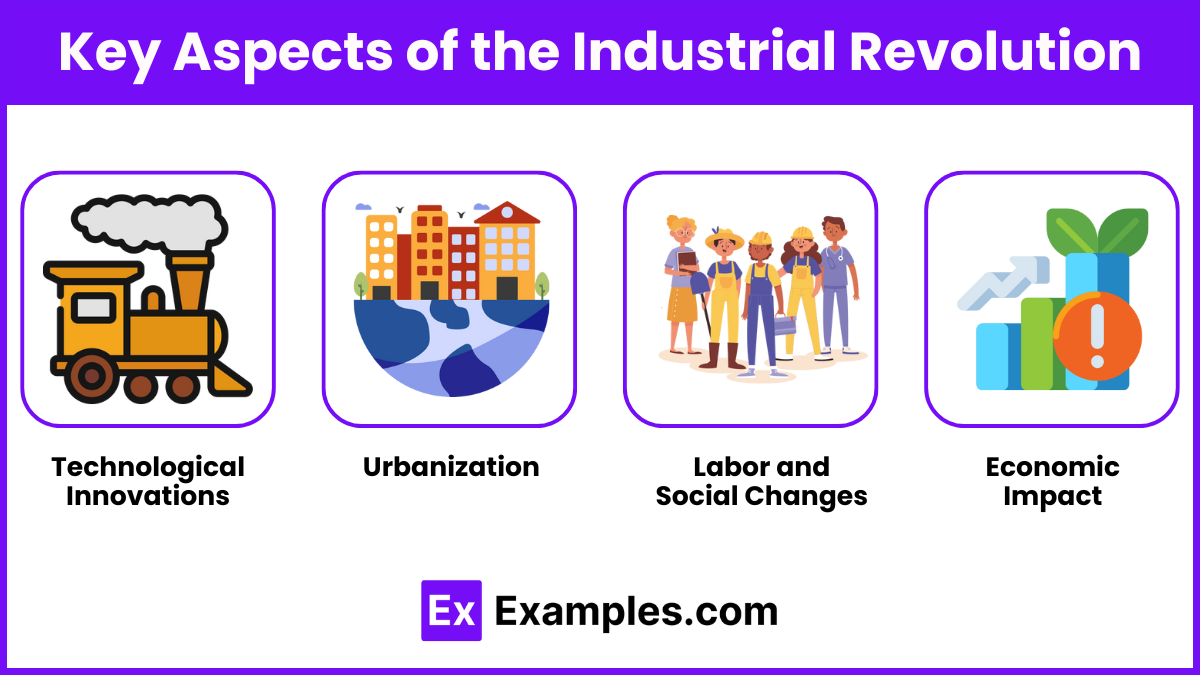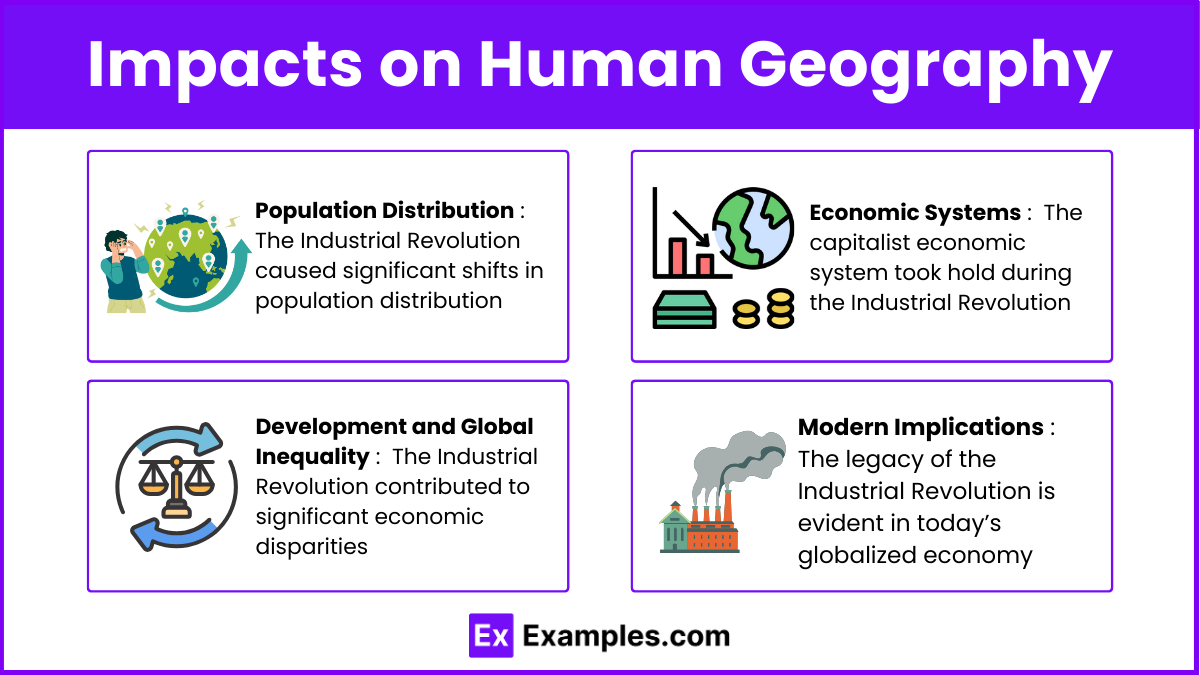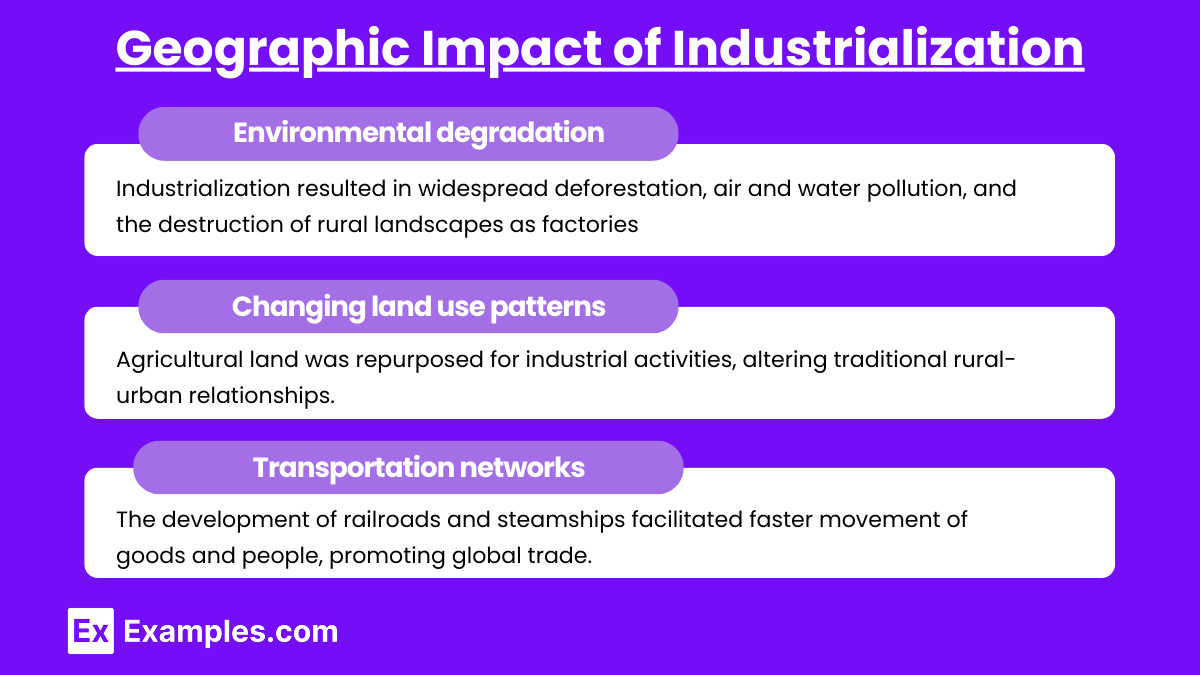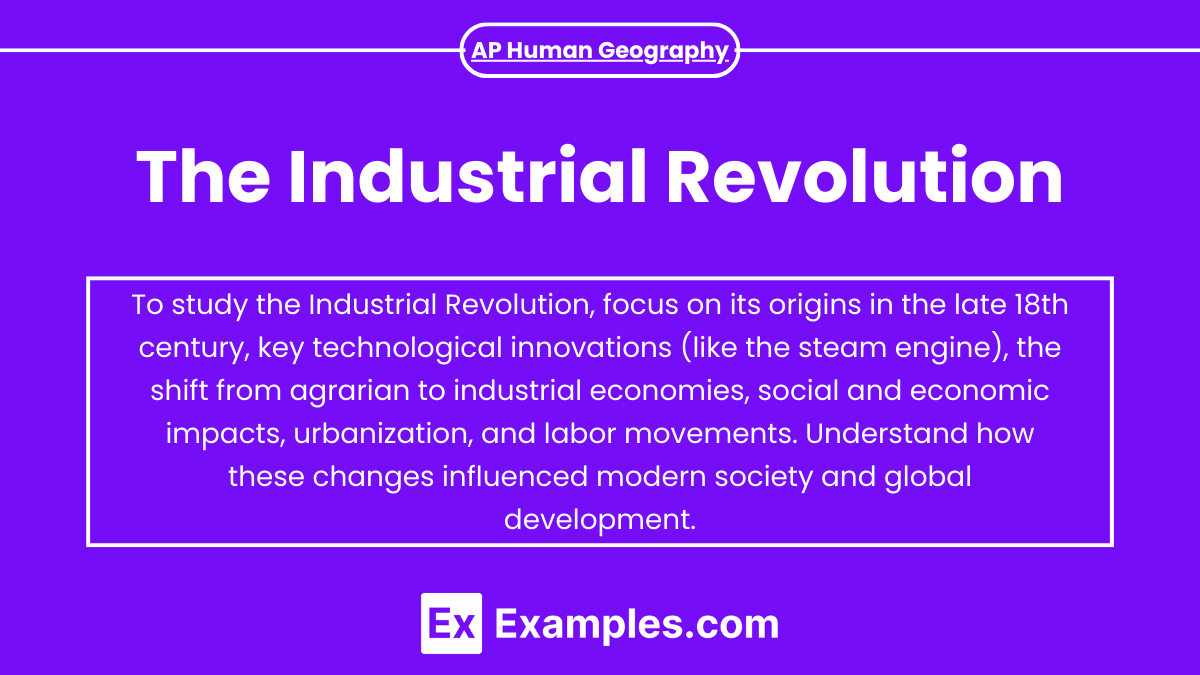The Industrial Revolution, a transformative period from the late 18th to mid-19th century, marked a shift from agrarian economies to industrialized societies. Originating in Great Britain, it revolutionized technology, manufacturing, and urbanization, profoundly impacting global economic systems and human settlement patterns. In AP Human Geography, understanding the Industrial Revolution is crucial for analyzing urban development, population shifts, and the rise of global trade networks. This period reshaped economies and continues to influence contemporary geographic landscapes, making it a key topic for the AP exam.
Learning Objectives
In studying the Industrial Revolution for AP Human Geography, you should learn how technological innovations transformed production, urbanization, and population distribution. Focus on understanding the causes and impacts of industrialization on economic systems, social structures, and environmental changes. Examine the geographic shifts in labor, global trade, and the spread of industrialization across regions. Additionally, analyze how industrialization influenced global inequalities, modern development, and urban growth, while also considering the long-term environmental consequences that continue to affect contemporary human geography.
The Industrial Revolution
The Industrial Revolution, spanning from the late 18th century to the mid-19th century, marks a transformative period in history where technological innovations radically altered how goods were produced and societies were structured. It began in Great Britain and eventually spread across Europe and North America, shaping modern industrialized economies. The Industrial Revolution’s significance in AP Human Geography lies in its profound impact on urbanization, population distribution, economic development, and global trade patterns. Understanding these changes is essential for achieving a high score on the AP Human Geography exam.
Key Aspects of the Industrial Revolution

- Technological Innovations
- Textile Industry: Innovations like the spinning jenny, water frame, and power loom revolutionized textile production, significantly increasing output and reducing labor costs.
- Steam Power: James Watt’s improvements to the steam engine enabled mechanized production and efficient transportation, powering factories and locomotives.
- Iron and Steel Production: Advances in metallurgy, particularly the Bessemer process, allowed for mass production of steel, which was crucial for building infrastructure such as railroads and factories.
- Urbanization
- The Industrial Revolution spurred rapid urbanization as people migrated from rural areas to cities in search of work in newly established factories.
- Major cities like Manchester, Birmingham, and London experienced unprecedented growth, leading to both economic opportunities and social challenges, such as overcrowding, poor sanitation, and the rise of slums.
- Urban planning became a necessity as governments began to address these challenges, laying the groundwork for modern urban design.
- Labor and Social Changes
- The shift from agrarian economies to industrial economies drastically altered labor structures. Many people, including women and children, found employment in factories under harsh conditions.
- The rise of factory work led to the growth of the working class, and the emergence of labor movements advocating for workers’ rights, better wages, and shorter working hours.
- Economic Impact
- The Industrial Revolution transitioned economies from being primarily agricultural to industrial and capitalist.
- Mass production reduced the cost of goods, making products more affordable and accessible to a broader population.
- It also established global trade networks, with industrialized nations seeking raw materials from colonies and other regions to fuel their factories.
Impacts on Human Geography

- Population Distribution
- The Industrial Revolution caused significant shifts in population distribution, as urban centers grew rapidly and rural areas declined.
- Cities became the economic hubs, and this urbanization trend continues to shape population geography today.
- Economic Systems
- The capitalist economic system took hold during the Industrial Revolution, with private ownership of the means of production becoming the norm.
- Industrialization led to the rise of new economic theories, such as socialism and communism, which sought to address the inequalities created by the capitalist system.
- Development and Global Inequality
- The Industrial Revolution contributed to significant economic disparities between industrialized and non-industrialized regions.
- Countries that industrialized first gained economic and military advantages, which they used to dominate global trade and colonial ventures.
- Modern Implications
- The legacy of the Industrial Revolution is evident in today’s globalized economy, where manufacturing, trade, and technology continue to shape human geography.
- Industrialization also paved the way for the modern environmental movement, as societies began to recognize and address the environmental costs of industrial activity.
Geographic Impact of Industrialization

- Environmental degradation: Industrialization resulted in widespread deforestation, air and water pollution, and the destruction of rural landscapes as factories, railroads, and mines expanded.
- Changing land use patterns: Agricultural land was repurposed for industrial activities, altering traditional rural-urban relationships. Urban sprawl became a prominent feature in industrialized countries, with slums and overcrowded neighborhoods emerging as common problems.
- Transportation networks: The development of railroads and steamships facilitated faster movement of goods and people, shrinking perceived geographic distances and promoting global trade.
Examples
Example 1: Textile Industry and Urbanization in Britain
The Industrial Revolution began in Britain, largely due to innovations in the textile industry. Machines like the spinning jenny and power loom increased textile production, reducing reliance on manual labor. As factories were established, people moved from rural areas to urban centers like Manchester and Liverpool in search of work. This mass migration led to rapid urbanization, changing the population distribution and creating densely populated industrial cities.
Example 2: The Growth of Railroads in Europe
Railroads were a critical development during the Industrial Revolution, transforming transportation networks in Europe. Railways facilitated the movement of raw materials to factories and finished goods to markets, which boosted economic growth. Cities connected by railways, such as London and Paris, became major industrial and commercial hubs. This new infrastructure also influenced human settlement patterns, with towns and cities developing around key railroad lines.
Example 3: Factory Labor and Social Changes in the United States
In the United States, the Industrial Revolution led to the rise of factory labor, especially in the northeastern states. Factories producing textiles, steel, and other goods became a primary source of employment. The factory system altered social structures, with the working class growing significantly. The harsh working conditions led to the formation of labor unions and movements that advocated for workers’ rights, shaping the social geography of industrialized cities like New York and Chicago.
Example 4: Environmental Impact in the Ruhr Valley, Germany
The Ruhr Valley in Germany became one of the most heavily industrialized regions in Europe due to its rich coal reserves. The establishment of coal mines, steel mills, and chemical plants led to significant environmental degradation, including air and water pollution. This industrial growth also transformed the landscape, as forests were cleared and towns developed around factories. The environmental consequences of industrialization became a key focus of later urban planning and environmental policies.
Example 5: Global Trade and Colonial Expansion
The Industrial Revolution fueled the demand for raw materials such as cotton, rubber, and minerals, which were sourced from colonies in Africa, Asia, and the Americas. Industrialized nations like Britain and France expanded their colonial empires to secure these resources. This economic dependency on colonies created global trade networks that integrated distant regions into the industrialized world economy. The colonial expansion reshaped global political and economic geography, leading to uneven development between industrialized and colonized regions.
Multiple Choice Questions
Question 1
Which of the following was a primary factor that contributed to the beginning of the Industrial Revolution in Great Britain?
A) Access to large amounts of gold
B) A highly skilled agricultural workforce
C) Abundant coal and iron resources
D) A strong reliance on subsistence farming
Answer: C) Abundant coal and iron resources
Explanation: The Industrial Revolution began in Great Britain largely because of its access to critical natural resources, particularly coal and iron. Coal was essential for powering steam engines, which drove much of the machinery used in factories. Iron was necessary for building machines, railways, and other infrastructure. Great Britain’s rich deposits of these materials, combined with its advanced infrastructure and colonial trade networks, allowed it to industrialize rapidly. Options A, B, and D are incorrect because gold, agriculture, and subsistence farming were not direct factors in industrialization.
Question 2
What was one significant effect of the Industrial Revolution on population distribution in Europe?
A) A large-scale movement from urban areas to rural farming communities
B) A sharp decline in the overall population
C) A rapid increase in urbanization and growth of cities
D) The equal distribution of population between rural and urban areas
Answer: C) A rapid increase in urbanization and growth of cities
Explanation: The Industrial Revolution led to rapid urbanization, as people moved from rural areas to cities in search of employment in factories. This marked a significant shift in population distribution, as cities grew exponentially in size and importance, particularly in industrial centers like Manchester, London, and Birmingham. The concentration of factories in urban areas drew laborers, causing massive population shifts. Option A is incorrect because people were moving from rural to urban areas, not the other way around. Options B and D do not accurately reflect the population trends during the Industrial Revolution.
Question 3
How did the Industrial Revolution impact global trade during the 19th century?
A) It reduced the need for raw materials from foreign countries
B) It led to the creation of localized, self-sufficient economies
C) It expanded global trade networks and increased demand for raw materials
D) It caused a decline in international trade due to protective tariffs
Answer: C) It expanded global trade networks and increased demand for raw materials
Explanation: The Industrial Revolution significantly expanded global trade networks as industrialized countries sought raw materials from colonies and other regions to fuel their factories. Cotton, rubber, metals, and other materials were imported from Africa, Asia, and the Americas, while finished products were exported back. This expansion of trade was driven by the increased production capacity of industrialized nations. Options A and B are incorrect because the need for raw materials increased, not decreased, and self-sufficiency was not a goal of industrial economies. Option D is incorrect because, despite the presence of some tariffs, international trade flourished during this period.


